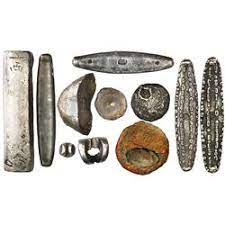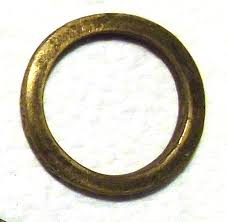Primitive Moneys And Bitcoin - The Island Of Rai Stone Money
Large round disks with a hole in the centre weighing up to four metric tons were used as currency by the Rai people. All of Yap's stones were brought in from nearby Palau or Guam and were not indigenous to the island. These stones were highly sought after in Yap due to their beauty and rarity, but obtaining them was very difficult due to the lengthy process of quarrying and delivering them via rafts and canoes.
Author:James PierceReviewer:Gordon DickersonFeb 09, 2022482 Shares120.4K Views

Large round disks with a hole in the centre weighing up to four metric tons were used as currency by the Rai people. All of Yap's stones were brought in from nearby Palau or Guam and were not indigenous to the island. These stones were highly sought after in Yap due to their beauty and rarity, but obtaining them was very difficult due to the lengthy process of quarrying and delivering them via rafts and canoes.
Hundreds of people were needed to carry some of these boulders, and they were then put in a prominent area on Yap so that everyone could view them. All that would happen if the stone were to be used as a payment method is for the owner to proclaim to everyone in town that the stone's ownership has now transferred to the receiver. The receiver might use the stone to make a payment anytime he liked since the whole community would know who had it. Because everyone knew who owned the stone, taking it was impossible.
Monetary System Worked Well For The Yapese
The Yapese used this monetary system for decades, maybe millennia. As long as the stones remained stationary, they could be used as currency everywhere on the island. The capacity to pay with fractions of a single stone, as well as the varying sizes of the stones, gave some degree of salability between scales. While it was difficult to find fresh stones in Yap and transporting them from Palau was time-consuming and expensive, this ensured the stones' long-term value.
As a result of the high expense of acquiring new stones in Yap, it made sense to take them as payment since the current supply was always more than the new supply that could be generated at any one moment. Furthermore, even while Rai stones were highly sought for, it was difficult for anybody to increase the supply of stones by importing additional rocks, no matter how desired they were. In 1871, an Irish-American captain named David O'Keefe was shipwrecked off the coast of Yap and rescued by the natives.
O'Keefe Saw A Profit Opportunity
Though he recognized a chance to profit from the island's coconuts, which he could sell to coconut oil makers, O'Keefe couldn't persuade its residents to work for him since they were happy in their tropical paradise and had no need for any money he could give them.
As a last resort, O'Keefe made his way to Hong Kong and purchased a large boat and explosives, which he then used on the island of Palau, where he used the explosives and modern tools to excavate several large Rai stones, which he then brought back to Yap and presented to the locals as payment for their coconuts. However, the villagers were not interested in receiving O'Keefe's stones, and the village leader forbade his people from laboring for them, declaring that the stones were of little value since they were so readily obtained. Only stones mined in the traditional manner by Yapese laborers would be acceptable in Yap.
O'Keefe was able to get the coconuts he needed from the island's residents despite their disagreement. There was turmoil on the island as a consequence of this, and eventually the end of Rai stones as currency. On the island now, the stones have a more ceremonial and cultural purpose, while contemporary government money is the most regularly utilized monetary form.
History Of Beads In Western Africa
Aggry beads, which were used as money in Western Africa for millennia, had a similar fate. Beads created from meteorite stones or handed down from Egyptian and Phoenician merchants are among the theories about their origin in western Africa. A high stock-to-flow ratio made them valuable over time in an environment where glassmaking equipment was costly and not widely available.
Beads, being little and precious, could be joined into chains, necklaces, or bracelets; nevertheless, this was far from ideal since there were many distinct types of beads instead of one standard unit. Easy to transport, they might easily be sold around the globe. Since a result, glass beads were cheap and had no monetary value in Europe, as their makers could easily flood the market with them—in other words, their stock-to-flow ratio was low. Consequently, glass beads were not used as currency in Europe.
European Explorers And Traders Visited West Africa In The Sixteenth Century
They began importing large numbers of these beads from Europe after realizing their great monetary worth. What happened next was quite similar to O'Keefe's account, but since the beads were so little and the population was so much greater, the process was more gradual, more hidden, and ultimately more devastating.
In exchange for the beads they had bought for so little back home, Europeans were able to slowly but surely acquire many of Africa's priceless resources. By importing beads from Europe, Europeans made it easier for the Africans who owned them to gain their riches, making them poorer and weakening their buying power over time as their wealth was transferred to the Europeans who could readily purchase beads.
Summary
Artifacts like this were soon superseded by human-made money as technology improved, notably in the field of metallurgy. Compared to seashells, stones, beads, livestock and salt, these metals proved to be a superior medium of trade because they could be produced into uniform and highly valued little units that could be transported about more quickly.

James Pierce
Author
James Pierce, a Finance and Crypto expert, brings over 15 years of experience to his writing. With a Master's degree in Finance from Harvard University, James's insightful articles and research papers have earned him recognition in the industry.
His expertise spans financial markets and digital currencies, making him a trusted source for analysis and commentary. James seamlessly integrates his passion for travel into his work, providing readers with a unique perspective on global finance and the digital economy.
Outside of writing, James enjoys photography, hiking, and exploring local cuisines during his travels.

Gordon Dickerson
Reviewer
Gordon Dickerson, a visionary in Crypto, NFT, and Web3, brings over 10 years of expertise in blockchain technology.
With a Bachelor's in Computer Science from MIT and a Master's from Stanford, Gordon's strategic leadership has been instrumental in shaping global blockchain adoption. His commitment to inclusivity fosters a diverse ecosystem.
In his spare time, Gordon enjoys gourmet cooking, cycling, stargazing as an amateur astronomer, and exploring non-fiction literature.
His blend of expertise, credibility, and genuine passion for innovation makes him a trusted authority in decentralized technologies, driving impactful change with a personal touch.
Latest Articles
Popular Articles
